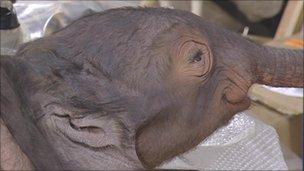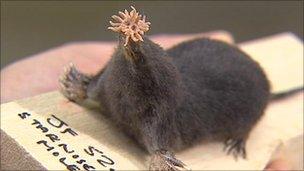Museum searches new 'realistic' animals for stuffing
- Published

A baby African elephant will be on display when the museum opens next summer
The National Museum of Scotland is replacing most of its collection of stuffed animals with new specimens which look more realistic.
Curators have been sourcing hundreds of new animals from all over the world in a bid to modernise their collection.
Using modern techniques taxidermists have set the animals in poses showing their natural behaviour.
The exhibits will be unveiled next summer when the museum is reopened following a three year revamp.
All the animals died in zoos before they were donated to the museum.
Andrew Kitchener, principal curator of vertebrates, told BBC Scotland they were still searching for a desert rat and an emu.
He said: "It tends to be the rare and endangered species people treat as very precious and so they look after them.
"But emus being so common presumably people disregard them and they are not kept like a lot of other animals we get from zoos.
"The animal I have struggled the hardest to get was the star-nosed mole, which has an amazing nose with 22 little fingers sticking out of it.

The star-nosed mole has a nose with 22 little fingers sticking out of it
"Finally after two years I found one at the Royal Ontario Museum in Canada."
He said the principle of taxidermy remains the same from when the original animals were stuffed but new materials had meant the animals would look more realistic.
He said: "A range of new materials that are now available means we can make the new specimens much lighter.
"We can also replace bits that might shrivel or look horrible with fibre glass casts of those bits, such as the legs and beaks, to make them look much more realistic.
"Unfortunately the old collection just got very faded in the sunlight and a bit dusty.
"What we want to do is show animals in their best way, which is their natural behaviour, so it has meant replacing hundreds and hundreds of specimens."
Visitors will be able to see a baby African elephant which died shortly after birth at Knowsley Safari Park in Merseyside.
They will also be able to see an example of the rare Aye Aye, a nocturnal lemur native to Madagascar, which died at Edinburgh Zoo, as well as a giraffe and hundreds of other animals.
- Published23 September 2010
- Published23 May 2010